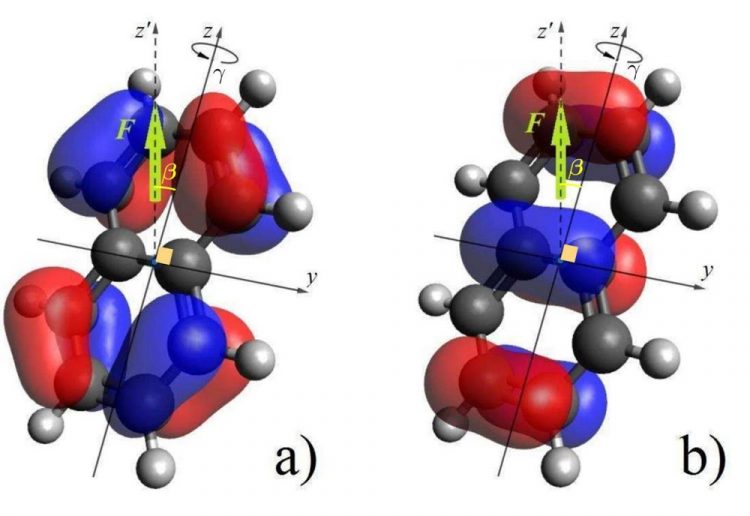Physicists edge closer to controlling chemical reactions

The orientation of the naphthalene molecule relative to the external electric field can be described by angles β and γ in the following manner: Electric field F is directed along axis z?, while β denotes the angle between z? and the molecular axis z, and γ is the rotation angle around axis z. The latter angle specifies an arbitrary orientation of the molecule relative to the field F. The two angles β and γ are known as Euler angles. The figure also shows two outer orbitals (a and b) of the naphthalene molecule -- that is, the areas where the two outer electrons are localized in this molecule. The outer electrons are the first to undergo ionization in the presence of an electric field. Credit: Image courtesy of the researchers
Physicists use powerful lasers to reveal the electron structure of molecules. To do this, they illuminate a molecule and analyze its re-emission spectra and the products of the interaction between the molecule and the electromagnetic field of the laser pulse. These products are the photons, electrons, and ions produced when the molecule is ionized or dissociates (breaks up).
Previous research involving MIPT's theoretical attosecond physics group led by Oleg Tolstikhin showed that besides elucidating the electronic structure of a molecule, the same approach may enable physicists to control the electron motions in the molecule with attosecond precision. An attosecond, or a billionth of a billionth of a second, is the time it takes laser light to travel the distance comparable to the size of a small molecule.
“If you place a molecule in a field of powerful laser radiation, ionization occurs: An electron escapes the molecule,” explains Andrey Dnestryan, a member of the theoretical attosecond physics group at MIPT. “The motion of the electron is then affected by the variable laser field. At some point, it may return to the parent molecular ion. The possible outcomes of their interaction are rescattering, recombination, and dissociation of the molecule. By observing these processes, we can reconstruct the motions of electrons and nuclei in molecules, which is of profound interest to modern physics.”
The interest in tunneling ionization stems from its role in experiments observing electronic and nuclear motion in molecules with attosecond time resolution. For example, tunneling ionization may enable researchers to track the motions of electrons and holes — positively charged empty spots resulting from the absence of electrons — along the molecule. This opens up prospects for controlling their motion, which would help control the outcomes of chemical reactions in medicine, molecular biology, and other areas of science and technology. Precise calculations of tunneling ionization rates are vital to these experiments.
The tunneling ionization rate could be interpreted as the probability of an electron escaping the molecule in a particular direction. This probability depends on how the molecule is oriented relative to the external magnetic field.
Currently used theories tie tunneling ionization rates to electron behavior far away from atomic nuclei. However, the available software for quantum mechanical calculations and computational chemistry fail to predict the state of electrons in those regions. The researchers found a way around this.
“We recently managed to reformulate the asymptotic theory of tunneling ionization so that the ionization rate would be determined by electron behavior near nuclei, which can be calculated rather precisely using the methods available now,” Dnestryan said.
“Until now, researchers could only calculate tunneling ionization rates for small molecules made of a few atoms. It is now possible for significantly larger molecules. In our paper, we demonstrate this by running the calculations for benzene and naphthalene,” the physicist added.
The authors of the paper calculated tunneling ionization rates for several molecules as a function of their orientation relative to the external field. To perform the calculations, the team developed software, which it plans to make openly available. This will enable experimenter to rapidly determine the structure of large molecules with attosecond precision based on observed spectra of the molecules.
“This work turns the asymptotic theory of tunneling ionization, which we developed in 2011, into a powerful tool for calculating ionization rates for arbitrary polyatomic molecules. This is essential for solving a wide range of problems in strong-field laser physics and attosecond physics,” Tolstikhinsaid.
###
The work was funded by the Russian Foundation for Basic Research according to the research project ? 18-32-00429.
Media Contact
All latest news from the category: Physics and Astronomy
This area deals with the fundamental laws and building blocks of nature and how they interact, the properties and the behavior of matter, and research into space and time and their structures.
innovations-report provides in-depth reports and articles on subjects such as astrophysics, laser technologies, nuclear, quantum, particle and solid-state physics, nanotechnologies, planetary research and findings (Mars, Venus) and developments related to the Hubble Telescope.
Newest articles

High-energy-density aqueous battery based on halogen multi-electron transfer
Traditional non-aqueous lithium-ion batteries have a high energy density, but their safety is compromised due to the flammable organic electrolytes they utilize. Aqueous batteries use water as the solvent for…

First-ever combined heart pump and pig kidney transplant
…gives new hope to patient with terminal illness. Surgeons at NYU Langone Health performed the first-ever combined mechanical heart pump and gene-edited pig kidney transplant surgery in a 54-year-old woman…

Biophysics: Testing how well biomarkers work
LMU researchers have developed a method to determine how reliably target proteins can be labeled using super-resolution fluorescence microscopy. Modern microscopy techniques make it possible to examine the inner workings…





















